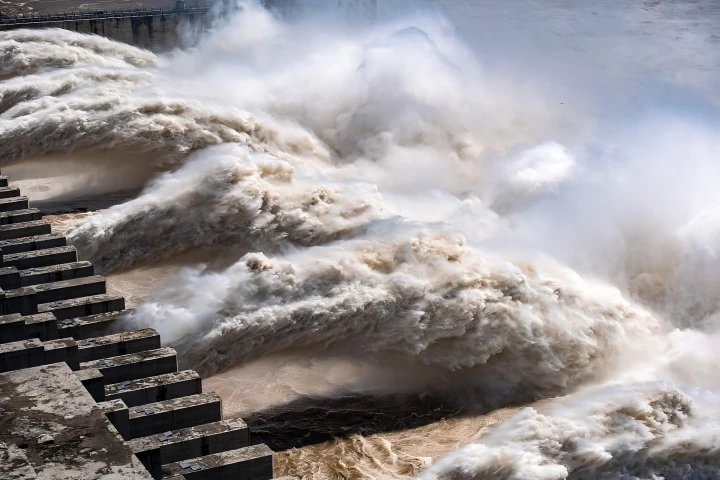- "Sometimes you have to go up really high to understand how small you are" – Felix Baumgartner, standing outside his capsule at an altitude of 24 miles (39 km) on October 14, 2012.
Well, Felix has gone and done it. Today over the arid countryside near Roswell, New Mexico, the Austrian daredevil successfully accomplished a feat that has been in the works since 2003 – he broke the record for the world’s highest parachute jump, dropping from an unofficial altitude of 128,100 feet (39,045 meters) – about 1.5 miles (2.4 km) higher than expected. In the process, he also became the first skydiver to exceed the speed of sound by reaching an estimated speed of 833.9 mph (1342.8 km/h) while in freefall. That's Mach 1.24 – the first supersonic skydive.Today’s Red Bull Stratos jump was originally supposed to take place last Monday and then on Tuesday, but was cancelled both times due to inclement weather. The jump was ultimately rescheduled to today, with the actual launch taking place at 9:31 am MDT (3:31 UTC). The ascent took about two and a half hours.
Early this morning, Baumgartner climbed into a custom-built fiberglass pressurized capsule, that provided him with oxygen and protection against the cold of the upper atmosphere. Additionally, because it was pressurized to the equivalent of 16,000 feet (4,877 meters) above sea level, it helped protect him from experiencing decompression sickness during his ascent. Although damaged upon landing during the second of two lower-altitude test jumps in July, the capsule was subsequently repaired.
The capsule was attached to a 55-story-tall high-altitude helium-filled polyethylene balloon, with a capacity of almost 30 million cubic feet (849,505 cubic meters). Despite its enormous size, however, the thickness of the balloon’s plastic skin was only .0008 inches (.02 mm) – about 40 percent of the thickness of a Ziploc bag, and equal to three red blood cells placed edge to edge. The balloon used for Tuesday's attempted launch touched the ground during a gust of wind and was destroyed. Fortunately, the Stratos team had an extra balloon and enough helium for another attempt.
That balloon proceeded to pull the capsule (and Baumgartner) up to the planned altitude, over the course of about two and a half hours. After he carried out the pre-jump checklist (including such items as insuring his emergency knife was secure), Felix stood on the outer step of the capsule for a moment, and then stepped off. Watching the live feed, it was remarkable to see the high speeds he almost immediately attained in the relative absence of air resistance.
Shortly after jumping, Felix found himself in a flat spin, a dangerous condition which often requires deploying a drogue parachute to regain control, which would likely have prevented his reaching supersonic speeds. Fortunately, he managed to stop the spin quickly, and retained control for the remainder of the jump. He experienced some fogging and icing of his faceplate during the jump, but this posed little danger to the endeavor.
After a bit more than 30 seconds of freefall, Baumgartner accelerated to his maximum velocity, which preliminary mission data set at 833.9 mph (1,342.8 km/h), or Mach 1.24. Given his altitude at this time, his speed corresponded to Mach 1.24 – a clearly supersonic velocity. Felix was in freefall for four minutes and twenty seconds, representing a record duration for jumps not using a drogue parachute to stabilize and slow the fall. After deploying his parachute at about 8,000 feet (2,400 meters), he landed on his feet outside Roswell, then went down on his knees to greet the ground.
Baumgartner, together with the Stratos team, broke four records today having to do with ballooning and parachuting.
- Highest manned balloon flight – 128,100 ft (39,045 m)
Previously, the highest manned balloon flight was 113,740 ft (34,668 m); the highest parachute jump was 102,000 ft (31,090 m); the fastest speed was 614 mph (988 kph).Baumgartner was also aiming to claim the longest duration freefall, but his 4 minutes, 20 seconds freefall fell 16 seconds short of the 4 minutes, 36 second record set by U.S. Air Force Col. Joe Kittinger in 1960. The now 84-year-old Kittinger was at Mission Control and in contact with Baumgartner before his jump.
As an interesting aside, it was 65 years ago today when Air Force Major General Chuck Yeager became the first man ever to break the sound barrier. Flying the Bell X-1 rocket plane with a set of broken ribs he got the evening before while riding a horse, he had to close the canopy of the X-1 using a broom handle. They approached matters differently back in the day.
Throughout the project, Baumgartner has maintained that it was more than just a stunt – he hopes that data obtained from the jump could be put towards developing systems that would allow astronauts to escape from malfunctioning spacecraft after launch. Such information might have helped save the crews of the Challenger and Columbia space shuttles, and will certainly be needed as commercial space flight makes its entrance.
Neither records nor science nor applications, however, affect the real impact of today's feat – a brave man testing himself and his technology against Nature. Many people will stand a little taller today as we contemplate the return to Roswell of a humanoid from the edge of space.
Update: a highlights video of Baumgartner's historic jump can be seen below.
Update 2: Baumgartner can lay claim to yet another record with Google confirming that a record number of more than eight million concurrent viewers watched his jump on Youtube.
Source: Red Bull Stratos
























